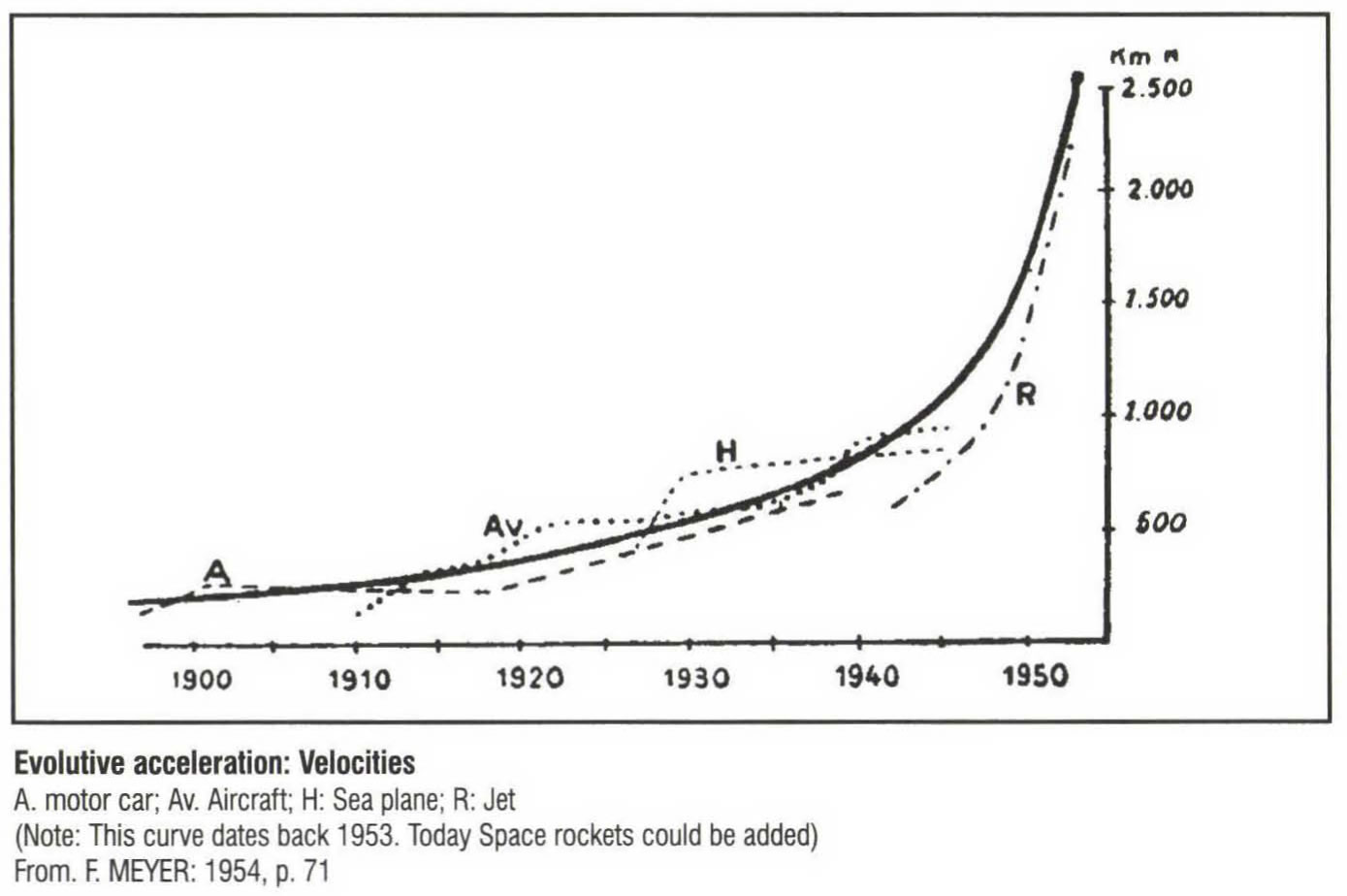EVOLUTIVE ACCELERATION 1)
← Back
F. MEYER dedicated an important book to the global problems of evolution, with an intriguing chapter on "Evolutive acceleration" (1954, p.173).
Various other authors did observe that many evolutive phenomena of very varied kinds seem to accelerate with time.
F. MEYER, in "La surchauffe de la croissance" (1974) emphasizes this process, at work in growth of the number of living species and the cephalization index of animal species; growth of human population planetary wide; of population density by square kilometer; of the length of cutting edges per kilo of stone from early paleolithic to late neolithic; of appearance of new types of tools during the same time-span; of urban concentration; of the quantitative use of energy; etc…
MEYER describes also some general and striking characters of these phenomena:
- Not only does acceleration take place, but altogether an acceleration of acceleration, which produces logarithmic and even in some cases hyperbolic growth.
- The mechanics of acceleration is a positive feedback (see figure).
- The hyper-acceleration process should normally be self -destructive.
- However, there is a relay mechanism by which, when the evolutive curve of a phenomenon starts to accelerate, some new phenomenon, more powerful, appears. As an example MEYER uses the growth of human displacement velocities from the old horse postal express up to the rocket. Today, he could add the interplanetary explorers.
- There is an evolution of evolution characterized by curve-embedding
MEYER gives the following cybernetic explanation of the acceleration phenomenon: (1974, p. 550)
H. SIMON viewed the phenomenon from the angle of complexification mechanism and his argument explains the existence of the evolutive relays noticed by F. MEYER:
"Using the simplest hypotheses, the time needed by a great system to its spontaneous build-up starting from its "atomic" components, grows geometrically according to the number of its components. On the other hand, if a hierarchy exists of potential subsets. with more or less the same number of components on each level, then the time needed to constitute a system of n elements grows only according to logn. In other words, when big systems are built according to this hierarchical method, the doubling in size of the bigger evolving systems will be more or less constant. It may be expected that systems of size 100 evolving in an environment of size 50 systems will do it more or less within the same span of time as size 50 systems evolving in an environment of size 25 systems" (1990, p.134).
We will thus witness a logarithmic growth of the size, and probably the general efficiency of systems in similar lapses of time.
F. MEYER gives still another interesting insight. He hypothizes that the general evolution process started on the morphological level and passed successively through the physiological and the behavioral one, reaching finally the technical one. This is related to the evolution of the brain: first global, next of its superior centers and finally of the cortex. (1954, p.174). In other words, evolution affected first material processes and is now acting on the information level, using energy in a quite more efficient way.
The topic has also been considered by C. BRESCH (1977) and H.von FOERSTER et al. (1960)


Categories
- 1) General information
- 2) Methodology or model
- 3) Epistemology, ontology and semantics
- 4) Human sciences
- 5) Discipline oriented
Publisher
Bertalanffy Center for the Study of Systems Science(2020).
To cite this page, please use the following information:
Bertalanffy Center for the Study of Systems Science (2020). Title of the entry. In Charles François (Ed.), International Encyclopedia of Systems and Cybernetics (2). Retrieved from www.systemspedia.org/[full/url]
We thank the following partners for making the open access of this volume possible:

